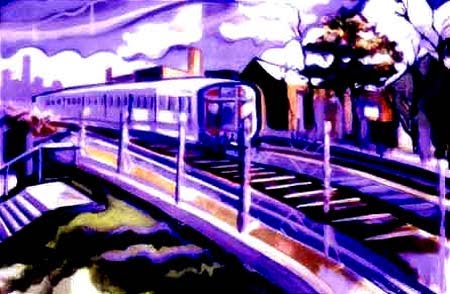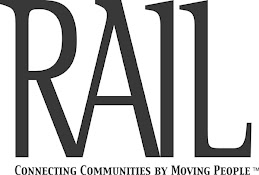Although its not quite the new year yet,
RAIL Magazine and your blogger are already making some resolutions for 2013. You'll hear more about these in detail over the coming days and week, but a few we can talk about now are a renewed focus to deliver at least one new
Potomac Express post each month, and a return to a regular schedule for publishing our
Fast Mail for RAIL e-newsletter. New posts here will also provide sneak-previews of upcoming editions of
RAIL, along with more well-designated call-outs to relevant content from past issues of
RAIL. And, as always, stay tuned to
@RAILMag on Twitter for up-to-the-minute passenger rail news.
In that spirit of welcoming some exciting developments for the year ahead, he's some of the projects and stories in North American passenger rail we're looking forward to covering in 2013, after 2012 offered some fantastic achievements, such as expansion of Amtrak service to Brunswick, Maine and Norfolk, Va., extended
FrontRunner regional rail service in Utah connecting Ogden, Salt Lake City and Provo and strong support from voters for new streetcar systems in Los Angeles and Kansas City, among much more. We'll count down our top ten in reverse order:
10) Inauguration of X Train Service Between Southern California and Las Vegas
 |
| Source: Las Vegas Railway Express |
The new luxury passenger rail service between Las Vegas and Southern California is targeted to begin operation in late 2013.
Las Vegas Railway Express – the private entity which will own the service – negotiated agreements with Union Pacific this past November to operate over their rails between Las Vegas and Daggett, California. The service may connect with
Amtrak Surfliner and
Metrolink commuter rail trains in Fullerton, linking the operation with the region's existing passenger rail network. The initiation of scheduled passenger rail service between Southern California and Las Vegas – which would be the first since Amtrak's
Desert Wind was discontinued in 1997 – could build momentum for approval of high-speed rail infrastructure in the corridor via the
XpressWest project.
Relevant
RAIL Coverage:
Only in Las Vegas (
RAIL #22)
9) MBTA Service to Cape Cod
 |
| Source: Boston Globe |
Another project to emerge late in 2012 is the resumption of passenger rail service from Boston to Cape Cod. Through the leadership of Massachusetts
Governor Deval Patrick's administration and the
Cape Cod Regional Transit Authority, Massachusetts Bay Transportation Authority (MBTA) commuter rail trains will be
extended on weekends between Memorial Day and Labor Day from their current terminus at Middleborough/Lakeville over the
Cape Cod Central Railroad and serve Buzzards Bay and the Hyannis Transportation Center, which offers connections to local and intercity bus routes. Fares are expected to run $30 each way and cover the cost of operations.
Relevant RAIL Coverage:
RAIL #8
8) Development of the Phoenix - Tucson Corridor
 |
| Source: Arizona Department of Transportation |
As Utah and New Mexico have now completed their efforts to link their largest population centers with regional rail systems – the aforementioned
FrontRunner in Utah and New Mexico's
Rail Runner Express between Santa Fe, Albuquerque and Belen – could Arizona be feeling left behind its regional counterparts? Plans appear to be moving quickly to
link Phoenix and Tucson with the type of high-frequency rail service enjoyed by their southwest and mountain west neighbors. With Phoenix rapidly expanding its
Valley Metro light-rail network and Tucson set to open its
Sun Link streetcar later this year, the region is already primed for enhanced rail connectivity. Initial plans also suggest a multi-route commuter rail system in and around Phoenix as part of the effort.
Relevant
RAIL Coverage:
Leading from the Front (
RAIL #28); Commuter Rail's Next Frontier (
RAIL #30)
7) Higher Speeds on the NEC
 |
| Source: Amtrak |
One of the less visible aspects of the investment in high-speed and intercity passenger rail that came out of the American Recovery and Reinvestment Act (ARRA) of 2009 has been the gradual upgrade of conditions on
Amtrak's signature corridor, the Northeast Corridor (NEC). The corridor initially was one of the largest recipients of that funding, which has only grown after projects in Florida, Ohio and Wisconsin were cancelled. Although the failure of those initiatives – and the continuation of California's high-speed rail project – have received the bulk of the coverage on high-speed rail in the U.S., Amtrak has been steadily rebuilding the highest volume and highest speed passenger rail corridor in the western hemisphere over the past decade (
read my assessment of the NEC here). Last fall, the railroad tested its
Acela Express trainsets at speeds up to 160 mph on improved stretches of track in Maryland and New Jersey, besting its own top speeds previously achieved on short segments in Massachusetts and Rhode Island. These incremental increases will reduce trip times as Amtrak adds additional Acela and Regional frequencies to meet demand on the corridor that is already carrying capacity loads. Moreover, the railroad recently announced plans to acquire new, next-generation high-speed rail equipment by the middle of the next decade, in advance of its
proposals to introduce parallel infrastructure over the next half-century to achieve true high-speed status.
6) Passenger Rail in North Carolina
 |
| Source: Triangle Transit |
Many states have been proactive leaders in supporting passenger rail in their states over the past several decades. California, Illinois, Oregon, Washington and Virginia all come to mind, and this topic will receive more extensive coverage in an upcoming post here. But few have done so as unassumingly as North Carolina. The state has been one of the most steady supporters of
intra-state Amtrak service, boosting reliability and frequency by improving infrastructure while also restoring a handsome portfolio of historic passenger stations. At the same time, Charlotte's
LYNX light rail has received its fair share of press for its rail-oriented development projects as ridership has grown and new extensions move forward. In the coming year, look for more developments in the Tarheel State, as former Charlotte Mayor Pat McCrory becomes governor. McCrory has been a vocal advocate of transit, transit-oriented development and livable communities, which should set the stage for continued improvement of state-supported intercity rail in the Raleigh-Durham - Charlotte corridor, along with the creation of a new union station in Raleigh, local rail transit in the
Triangle Region and
new streetcar, light rail and commuter rail lines in Charlotte.
Relevant
RAIL Coverage:
Charlotte LYNX – A Rail History Lesson (RAIL #22); RAIL #5
5) Intercity Rail in the Midwest
 |
| Source: Kalamazoo Gazette |
In the waning days of 2012, rail advocates
celebrated the first test of a new higher-speed rail segment around Dwight, Illinois. The state is in the process of upgrading its Chicago – St. Louis corridor to achieve 110 mph speeds, which will allow for new frequencies, improved reliability and reduced trip times.
Recent decisions by the Federal Railroad Administration will allow further work to continue on the corridor between Chicago and Joliet and through downtown Springfield. Elsewhere, the state of Michigan and Norfolk Southern move closer to a final agreement to transfer control of the Detroit – Kalamazoo corridor to state ownership, which I covered extensively in
this post. Meanwhile, Illinois continues to prepare for its launch of new service from Chicago to Moline and the Quad Cities in 2015, which may be extended to Iowa City and ultimately Omaha if elected officials in that Iowa approve investment to support its operations. At the same time, Indiana leaders must determine if they will support Amtrak's four-times weekly Hoosier State service between Chicago and Indianapolis, which is scheduled to be suspended later this year without state-level support. Other intercity routes in Missouri, Ohio and Wisconsin may see activity, along with efforts to extend the existing Heartland Flyer north from Oklahoma City, potentially connecting as far as Kansas City.
Relevant RAIL Coverage:
Rising in the Midwest (
RAIL #18);
Iowa's Passenger Rail Experience...Continues (
RAIL #14)
4) Northern Virginia's Silver Line Metro
 |
| Source: Dulles Corridor Rail |
One of the nation's largest rail transit projects is nearing completion of its first phase, as the new
Silver Line of the Washington metropolitan region's
Metro rail network plans extends service to five new stations in Tysons Corner and Reston in Fairfax County this coming December. Tysons Corner is one of the nation's largest business districts and will be served by four distinct stations, with neighboring Reston serving as the end of the 11.6-mile first phase until 2016, when another 11.5-mile extension reaches Herndon,
Dulles International Airport and communities in Loudon County. In all, the Silver Line will add 11 new stations and 23 miles of new track to the region's existing 106-mile rail network, the second largest rail transit system in the nation in both passengers and mileage, after only the New York City Subway.
Relevant
RAIL Coverage:
RAIL #24 focus on rail-airport connections;
Defined by Distinctiveness – Washington, D.C.'s Metro (
RAIL #19)
3) All Aboard Florida
 |
| Source: All Aboard Florida |
In under a year, the privately-supported
All Aboard Florida effort through the Florida East Coast Railway (FEC) between the Orlando International Airport and downtown Miami has sprung from nothingness to a project nearing groundbreaking, construction and purchase of vehicles. I provided my assessment of the initiative earlier this year in
this post. Just before the holidays, Florida officials approved negotiation with FEC to lease portions of the Beeline Highway between Cocoa and the airport to compliment FEC's existing rail line between Cocoa and Miami. Those negotiations should be completed this spring or summer, and construction is likely to begin on new passing sidings on the FEC route as well as stations at the airport, downtown Miami, West Palm Beach and Fort Lauderdale, along with the acquisition of locomotives and railcars.
Relevant
RAIL Coverage:
Two of a Kind – Miami's Metrorail & Metromover (
RAIL #19)
2) Streetcars
 |
| Source: City of Cincinnati |
2013 may prove to be a banner year for the development of new streetcar projects in the U.S. Until now, streetcar applications have been limited to modern systems in the Pacific Northwest (
Seattle,
Portland,
Tacoma), historic-themed operations in the Southeast (
Tampa,
Memphis,
Little Rock) and holdover networks (
Boston,
Philadelphia,
San Francisco,
Toronto). As mentioned above,
Tucson's Sun Link will open later in 2013, marking the first modern streetcar service in the Southwest. On the horizon are routes currently under or nearing construction in
Atlanta,
Charlotte,
Cincinnati,
Dallas and
St. Louis, and recent voter-approved systems in
Kansas City and
Los Angeles will transition from planning to engineering. The strategies and rationale used in these communities may likely embolden others to cultivate proposals into action.
Relevant
RAIL Coverage:
United Streetcar – Making it in America (
RAIL #27); The North American Streetcar Overview (
RAIL #26);
The South Lake Union Streetcar (
RAIL #22)
Revisioning the American Streetcar (
RAIL #20);
Connecting the Dots – Tampa's TECO Line Streetcar (
RAIL #15)
1) Groundbreaking for California High-Speed Rail
Perhaps the most momentous occasion in passenger rail over the past half-century will occur this coming year in the California's Central Valley, when federal, state and local officials will gather to turn over ground for the first phase of construction for
California's planned high-speed rail network. While much of the superficial coverage will focus on how the initial segment will be built in the state's less-populated agricultural corridor and won't reach either the Bay Area or Southern California for another decade, massive public infrastructure projects must begin somewhere and that's usually the place where it's easiest to accomplish. The nation's first interstate highway segment opened in rural Missouri and it took 13 Apollo missions to reach the moon. Patience is required for such a massive undertaking, one that could massively impact California's economy and communities for generations and centuries after its completed.
Relevant
RAIL Coverage:
The Grand Central Terminal of the West (
RAIL #21)
RAIL #11














